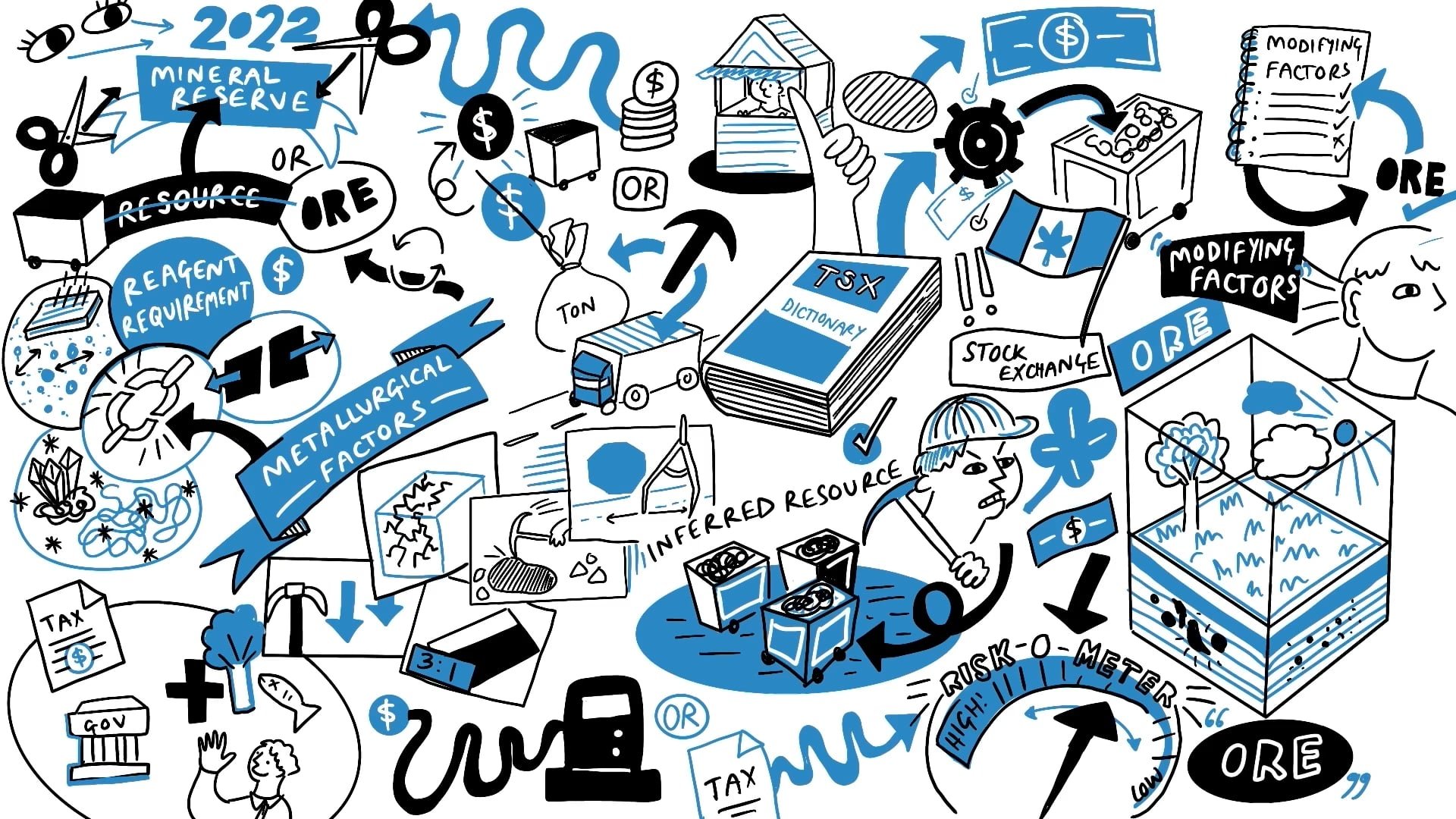Strategy: The Lassonde Curve

More episodes
Transcript
Many junior companies refer to the Lassonde curve in their presentations. It's a somewhat simplistic analysis, but a useful indication that the management team are actually considering how they're creating capital value growth for shareholders. It's also an indication that they're already thinking about exit strategy. Ultimately, to make money from a resource, you must dig it out of the ground and sell the product for a greater amount than it costs you to find the resource, study it, build it and extract it. Therefore, if you can sell it for $2,000 per ounce and it costs you less than $2,000 per ounce, in theory you make a profit. However, that timeline can be extremely long and some companies will prefer to sell the resource in the ground at an earlier point.
Coming back to the Lassonde curve, it begins with discovery rather than exploration. What it doesn't show you is a huge tail off to the left on the time axis where these junior companies pad around looking and testing a whole host of anomalies or sub-optimal projects. The Lassonde curve is overly simplistic as it really only begins from the point of discovery. That killer discovery hole is very difficult to make and it's very exciting when it comes. It's pure value creation in the discovery phase.
You can imagine it like catching a wave if you've been at the back waiting for a wave and waiting and waiting for that one wave and when it comes. If you catch it, my goodness, it's exciting. It's the ride of a lifetime. And that is the front part of the Lassonde curve, which comes when companies have got the right land position and they're able to deliver stellar exploration results over a period of one or two, possibly three years. And they can create continual growth stories in the form of new releases as they intersect wide good grades of mineralization.
This is absolutely the most exciting point in the cycle. You've got all of that hope and expectation. You've got this wide open mineral resource, which is growing and growing and growing. Fantastic. But I often see retail investors pick up the story in that phase and they follow it and they cling on for many years afterwards. But you must remember to be disciplined. You've got to top cut your position because it's in that first phase that you're going to make most of your money. Don't ride it for too long. For the first one or two years, you need to keep top slicing and if you want to keep your original stake in the stock by all means do so but take as much money as you can while maintaining your original position or your toehold position in terms of value.
The reason for this is because the next stage in the Lausanne curve is the study phase of the curve when the envelope of fresh mineralisation has been defined. Growth is over. You can imagine it like inflating a balloon. You blow up your balloon and during that blowing up phase it becomes a globe. You get your globe of known mineralization and that's what happens in the discovery phase. It gets to the maximum size and you can't go any further due to the nature of the geology or indeed in the nature of the metaphor the elasticity of the balloon. That is the shape of your deposit whether it's long and skinny or round or planar that's the envelope of mineralization. It's the most exciting part that typically delivers value to the shareholders in defining that envelope but once it's defined is pretty much over.
Once you delve into the more granular analysis of the study, you start applying these Modifying Factors. You look into how economic getting into the resource will be. You look at the confidence curve from inferred to measured and indicated resources. Typically share prices stagnate or indeed fall. During this phase of the life of a mineral asset, the company spends a lot of time grappling with the modifying factors.
These modifying factors are essentially all of the details that affect whether it can be extracted out of the ground at a profit or not. And the balance of probabilities and the balance of nature means that during this period, quite a lot of the news is not exciting. It's actually likely to be bad news, not good news. And this can actually clip the wings of shareholders' hopes and expectations. I will cover the resource growth aspects of a company, that the challenge of feasibility studies and the relationship between the increase in the size of the envelope and the increase in the confidence of each element of the material contained within the envelope as seen through the lens of modifying factors in a separate episode of the Con. It's really important.
In short, however, during the study phase of the Lausanne curve, share prices can stagnate or fall. Once you come to the end of your study phase, what typically happens is that when the company gets financed, when the feasibility study is completed, when the mine permit is issued, and when a company completes its financing structure, it's at this point that you get the closure of the discount to NPV, and particularly as the company comes into production. This is a simplistic analysis, and you've got many, many other factors to consider, which will dilute the impact of this pure analysis. However, in theory it's good, but in practice you have, oh my goodness, I mean, where to start?
For example, between 2011 and 2017, perhaps 2018, it was almost impossible to find capital to build your project. Actually, the share prices didn't rise after you produced a feasibility study. And when you got the mine permit, again the share price didn't rise because now the market thought, okay, now they need to raise the money to build.
From about 2012 onwards, exploration was so out of favour that it was actually a waste of money to invest in exploration because unless the results were truly stellar, if you put out good news, the market just thought you'd need more money for further drilling and therefore it sent the share price down. It was so out of favour that almost anything you did didn't enable the Curve to work.
In essence, the cycle at that point was the driving force. And this Lassonde curve as a kind of a concept didn't work in the downdraft of that horrific downturn. Outside of that window of time, 2011 to 2017, I've seen companies who typically have multiple projects in their portfolio. Another fact to consider is that some companies have multiple projects in their portfolio. So you don't get a simple valuation curve like the Lassonde curve theory. It's a much noisier, much messier share price graph.
Issues such as management skills, funding choices, strategic decisions, jurisdiction risk. Essentially everything that's kind of covered in this podcast and the series of podcasts has a part to play in whether the Lassonde Curve plays out perfectly or not. And in essence it really does. But the concepts are still valid. You get that growth through exploration in that
discovery phase, you have that stagnation through the study phase, and you have the de-risking, the capital value growth as you unlock the intrinsic value of each ton of material.
So. Coming back to the exploration part of the graph, it's worth reiterating that exploration is very difficult and truly economic all bodies are very rare. Retail investors in particular and some institutional investors (I've seen this happen a few times), the investor will buy into a management team or buy into a thesis and it's almost like kind of cognitive dissonance or cognitive bias. That there's an emotional attachment to the story that doesn't correlate to the true nature of the geology. The unfortunate fact is that most of the assets being talked about are never coming out of the ground. It can take a great deal of time and money to make that discovery hole. So when it does come and you see that discovery hole, you surf that wave for one, two or three years, but then you've got to have the discipline to top cut, reduce your position and take out as much as you feel is appropriate of your investment. It could be all of it if you're in a bear market. If you still like the underlying fundamentals of the commodity, you might want to keep more of your position in that company to maintain exposure to that good asset in that good commodity.
But anyway, you need to have the discipline to think about that investment point rationally. Finally, I will say that discoveries are typically made by small teams in small companies which have small market capitalizations. They often have a director or a founder who's a geologist, sometimes wrapped up in one, that founder CEO role. It's a very specific skill set. These are typically self-reliant people that can go into a country, manage a team, manage the community, manage government relations, and they do it very well.
Geologists are a funny breed however, they are emotional, they're temperamental, they are mavericks. They've got a scientific base, yes, but they've also got this creative streak to them. Geologists make very good pioneers. In the Soviet geological system, the geologists were equipped and treated like a wing of the army. They were frontier scouts used to run geological expeditions to get military-grade camping equipment and they used to go out from six to seven months at a time into these remote communities.
It's very much like the scout element of the military. And not to militarize exploration teams, but that pioneering self-reliance. And in a smaller company, you really want to see it actually understand it and get there out on the ground. That works well at the smaller end of the sector. But it means that once that discovery is made, you need to see if the company can make the transition that is needed to mature.









































.jpg)
.jpg)
.jpg)
.jpg)














